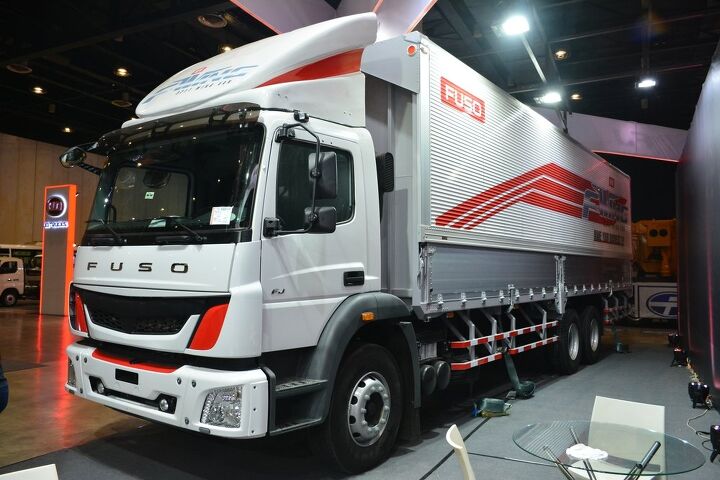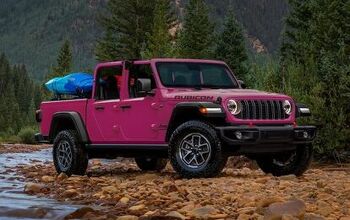Toyota & Daimler Merging Hino & Mitsubishi Fuso Truck Brands

On Tuesday, Toyota Motor Corp. confirmed plans to merge its truck-making subsidiary Hino Motors with the rival Mitsubishi Fuso that’s owned by Daimler AG.
If you’re confused by the news, Mitsubishi only has a minority stake in the Fuso brand with Germany’s Daimler having owned 89 percent of the whole since the early 2000s. Meanwhile, Hino Motors has been wholly owned by Toyota Motor Corp. since 2001 and enjoyed a working partnership with Japan’s largest automaker since the 1960s.
Now, Fuso and parent Daimler Truck have signed a memorandum of understanding with Hino and parent Toyota. Their stated plan involved merging Hino and Fuso into a publicly-traded holding company with equal investments from both Toyota and Daimler Truck Holding AG.
While probably not the hottest news for automotive enthusiasts, it remains a massively important deal for anybody tracking the broader industry or who happens to have a penchant for flat-faced box trucks. Despite being ideal for hauling heavy loads in dense urban areas, and longer routes in a pinch, smaller box trucks have been losing ground to the likes of the Ford Transit and Mercedes Sprinter.
According to Automotive News, the newly partnered Hino Motors and Mitsubishi Fuso Truck and Bus Corp. will be collaborating on commercial vehicle development, procurement, and production. Their stated goal is to become a "globally competitive" Japanese truck maker with an emphasis on serving Southeast Asia as the primary market.
From Automotive News:
"Behind this collaboration is our four companies' strong desire to create the future of commercial vehicles together," Toyota CEO Koji Sato said at a Tokyo news conference.
The shuffle comes as Toyota's Hino digs out of an embarrassing emission and fuel efficiency scandal and as Daimler looks to streamline its commercial truck holdings. Daimler separated its truck and car units in 2021 as part of a wider industry trend of spinning off commercial vehicles.
Nissan sold its truck subsidiary to Volvo in 2007, Volkswagen renamed its truck and bus unit Traton in 2018 and listed it on the Frankfurt and Stockholm stock exchanges the following year.
Hino fell into trouble in March 2022 with the revelation it had been falsifying emissions and fuel economy data dating as far as 2003. The scandal snowballed later that year when Hino said new problems were discovered in a light-duty engine, among revelations in other power plants.
Emissions issues are becoming incredibly difficult for manufacturers to contend with. But this has become especially true for commercial vehicles which need to keep costs and complexity down to help with fleet sales. As excited as some of the larger businesses seem to be about electrification, most small and middle-sized businesses tend to prefer basic vehicles that won’t break the bank — regardless of whether we’re talking about the initial investment or maintenance costs.
However, it sounds as though Toyota and Daimler want their truck division to chase down modern trends. Vehicle development is supposed to focus on achieving carbon neutrality and the duo claimed that Fuso and Hino would support the development of hydrogen, autonomous, connected, and electrified technologies.
"Simply put, the world is changing, and our industry needs to change with it," Mitsubishi Fuso CEO Karl Deppen stated.
Additional details of the merger are supposed to be decided over the next 18 months. The involved businesses want a definitive agreement in the first quarter of 2024 and for the deal to close by the end of next year. That means we’ll be getting updates on the corporate structure and a financial breakdown of who owns what. Assuming this is to be a complete merger, the joint trucking arm is also likely to need a new name — as Mitsubishi-Fuso-Hino is quite the mouthful.
Obviously, the deal could fall through before next year. But, with both brands having suffered trouble in recent years, it makes sense for their parent companies to chase down synergies in the hopes that it’ll yield something they can both profit from while sharing the investment burden.
[Image: Walter Eric Sy/Shutterstock]
Become a TTAC insider. Get the latest news, features, TTAC takes, and everything else that gets to the truth about cars first by subscribing to our newsletter.

A staunch consumer advocate tracking industry trends and regulation. Before joining TTAC, Matt spent a decade working for marketing and research firms based in NYC. Clients included several of the world’s largest automakers, global tire brands, and aftermarket part suppliers. Dissatisfied with the corporate world and resentful of having to wear suits everyday, he pivoted to writing about cars. Since then, that man has become an ardent supporter of the right-to-repair movement, been interviewed on the auto industry by national radio broadcasts, driven more rental cars than anyone ever should, participated in amateur rallying events, and received the requisite minimum training as sanctioned by the SCCA. Handy with a wrench, Matt grew up surrounded by Detroit auto workers and managed to get a pizza delivery job before he was legally eligible. He later found himself driving box trucks through Manhattan, guaranteeing future sympathy for actual truckers. He continues to conduct research pertaining to the automotive sector as an independent contractor and has since moved back to his native Michigan, closer to where the cars are born. A contrarian, Matt claims to prefer understeer — stating that front and all-wheel drive vehicles cater best to his driving style.
More by Matt Posky
Latest Car Reviews
Read moreLatest Product Reviews
Read moreRecent Comments
- Tassos Obsolete relic is NOT a used car.It might have attracted some buyers in ITS DAY, 1985, 40 years ago, but NOT today, unless you are a damned fool.
- Stan Reither Jr. Part throttle efficiency was mentioned earlier in a postThis type of reciprocating engine opens the door to achieve(slightly) variable stroke which would provide variable mechanical compression ratio adjustments for high vacuum (light load) or boost(power) conditions IMO
- Joe65688619 Keep in mind some of these suppliers are not just supplying parts, but assembled components (easy example is transmissions). But there are far more, and the more they are electronically connected and integrated with rest of the platform the more complex to design, engineer, and manufacture. Most contract manufacturers don't make a lot of money in the design and engineering space because their customers to that. Commodity components can be sourced anywhere, but there are only a handful of contract manufacturers (usually diversified companies that build all kinds of stuff for other brands) can engineer and build the more complex components, especially with electronics. Every single new car I've purchased in the last few years has had some sort of electronic component issue: Infinti (battery drain caused by software bug and poorly grounded wires), Acura (radio hiss, pops, burps, dash and infotainment screens occasionally throw errors and the ignition must be killed to reboot them, voice nav, whether using the car's system or CarPlay can't seem to make up its mind as to which speakers to use and how loud, even using the same app on the same trip - I almost jumped in my seat once), GMC drivetrain EMF causing a whine in the speakers that even when "off" that phased with engine RPM), Nissan (didn't have issues until 120K miles, but occassionally blew fuses for interior components - likely not a manufacturing defect other than a short developed somewhere, but on a high-mileage car that was mechanically sound was too expensive to fix (a lot of trial and error and tracing connections = labor costs). What I suspect will happen is that only the largest commodity suppliers that can really leverage their supply chain will remain, and for the more complex components (think bumper assemblies or the electronics for them supporting all kinds of sensors) will likley consolidate to a handful of manufacturers who may eventually specialize in what they produce. This is part of the reason why seemingly minor crashes cost so much - an auto brand does nst have the parts on hand to replace an integrated sensor , nor the expertice as they never built them, but bought them). And their suppliers, in attempt to cut costs, build them in way that is cheap to manufacture (not necessarily poorly bulit) but difficult to replace without swapping entire assemblies or units).I've love to see an article on repair costs and how those are impacting insurance rates. You almost need gap insurance now because of how quickly cars depreciate yet remain expensive to fix (orders more to originally build, in some cases). No way I would buy a CyberTruck - don't want one, but if I did, this would stop me. And it's not just EVs.
- Joe65688619 I agree there should be more sedans, but recognize the trend. There's still a market for performance oriented-drivers. IMHO a low budget sedan will always be outsold by a low budget SUV. But a sports sedan, or a well executed mid-level sedan (the Accord and Camry) work. Smaller market for large sedans except I think for an older population. What I'm hoping to see is some consolidation across brands - the TLX for example is not selling well, but if it was offered only in the up-level configurations it would not be competing with it's Honda sibling. I know that makes the market smaller and niche, but that was the original purpose of the "luxury" brands - badge-engineering an existing platform at a relatively lower cost than a different car and sell it with a higher margin for buyers willing and able to pay for them. Also creates some "brand cachet." But smart buyers know that simple badging and slightly better interiors are usually not worth the cost. Put the innovative tech in the higher-end brands first, differentiate they drivetrain so it's "better" (the RDX sells well for Acura, same motor and tranmission, added turbo which makes a notable difference compared to the CRV). The sedan in many Western European countries is the "family car" as opposed to micro and compact crossovers (which still sell big, but can usually seat no more than a compact sedan).
- Jonathan IMO the hatchback sedans like the Audi A5 Sportback, the Kia Stinger, and the already gone Buick Sportback are the answer to SUVs. The A5 and the AWD version of the Stinger being the better overall option IMO. I drive the A5, and love the depth and size of the trunk space as well as the low lift over. I've yet to find anything I need to carry that I can't, although I admit I don't carry things like drywall, building materials, etc. However, add in the fun to drive handling characteristics, there's almost no SUV that compares.


































Comments
Join the conversation
Sounds anticompetitive. Or maybe Toyota wants to get out of the truck business rather than have to get involved in electrification?
Another successful automotive company for Daimler to tear down. We all know how Chrysler was torn apart.....now round two.